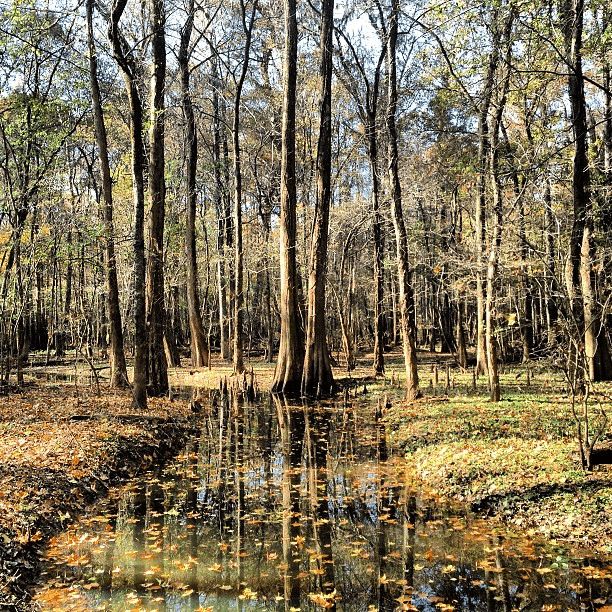The Ultimate Guide: Congaree National Park

Congaree National Park is a beautiful natural preserve located in South Carolina. The park is home to a wide variety of plant and animal life, as well as many recreational opportunities for visitors. In this article, we will explore the park’s history, main sections, essentials, things to know, best hikes, accommodations, safety, and what’s in the surrounding area.
For a condensed view of the park feel free to check out rvResortScouts Congaree National Park Information listing.
Park History / General Overview
The park’s history goes back to the native Congaree people, who lived in the area for thousands of years. They relied on the Congaree River for food and transportation. European settlers arrived in the 1700s and used the river to power mills and grow crops. But in the early 1900s, logging companies cut down most of the trees in the area. Conservationists fought to protect the remaining forest, and in 1976 it became a National Natural Landmark. In 1988, it was designated a wilderness area, and in 2003 it officially became Congaree National Park.
The park is home to one of the largest remaining expanses of old-growth bottomland hardwood forest in the southeastern United States. This means that the trees in the park are some of the oldest and tallest in the area. The park’s trees can reach up to 165 feet tall and can live over 500 years. The park is also home to a wide variety of plant and animal life, including the federally endangered red-cockaded woodpecker and the state-endangered dwarf palmetto.
The park offers a unique opportunity for visitors to experience the natural beauty of a bottomland hardwood forest and learn about the importance of conservation. It’s a great place for hiking, camping, bird watching and fishing. The park also offers ranger-led tours and educational programs that help visitors understand the ecological significance of the area.
Getting Oriented
The park is divided into two main sections: the Weston Lake area and the Longleaf Trail area. The Weston Lake area is the main section of the park and is where the visitor center and most of the park’s amenities are located. Visitors can find the park’s campground, picnic areas, and restroom facilities in this section. The Longleaf Trail area is a more remote section of the park that is accessed by a separate road. This area is home to several hiking trails, including the eponymous Longleaf Trail, as well as the park’s backcountry campsites.
The park’s main road, Harry Hampton Memorial Highway, runs through the Weston Lake area and provides access to the visitor center, campground, and several hiking trails. Visitors can also find the park’s main parking lot and the Harry Hampton Visitor Center at the end of the highway. The Longleaf Trail area can be accessed by taking the park’s secondary road, Bluff Road. This area is less developed and is a great place for visitors looking for a more wilderness experience.
It’s important for visitors to know that some trails and facilities may be closed during certain seasons or due to weather conditions. Visitors should check the park’s website or ask at the visitor center for the latest information.
Visitors can also obtain a park map at the visitor center or online, which will help them navigate the park and plan their visit. The park map includes information on trail distances, difficulty levels, and points of interest.

Congaree National Park Essentials
To get to Congaree, take exit 108 off of I-77 and follow the signs for Harry Hampton Memorial Highway. The park’s visitor center is located at the end of the highway and is open year-round. Visitors should plan to stop at the visitor center to get information about the park, including trail maps, current conditions, and any closures or alerts.
The park has several rules and regulations that visitors must follow to help preserve the park for future generations. These include:
- Not disturbing plants or animals
- Not leaving the designated trails
- Do not bring in pets or weapons
- Not collecting any plants, animals, rocks, or artifacts
- Follow all posted signs and instructions
Visitors should also be aware of the park’s hours, which are subject to change. The park is open 24 hours a day, but certain areas may have specific hours. The visitor center is open year-round, but hours may change based on the season.
It’s recommended for visitors to bring enough water, wear comfortable shoes, and dress appropriately for the weather. The park can be hot and humid during the summer and visitors should be prepared for biting insects. Visitors should also bring sunscreen and a hat to protect from the sun.
Any guest should also be aware that there is no potable water or food available in the park, so they should plan accordingly. Visitors should also bring their own trash bags and dispose of trash in the designated areas.
Things You Need To Know
When visiting Congaree National Park, it is important to be prepared. Here are some things you need to know:
- What to Pack: Visitors should pack enough water, wear comfortable shoes, and dress appropriately for the weather. The park can be hot and humid during the summer, so visitors should bring bug spray, sunscreen, and a hat to protect from the sun. Visitors should also bring their own trash bags and dispose of trash in the designated areas.
- Amount of Food Needed: There is no potable water or food available in the park, so visitors should plan to bring enough food and water for their visit. The park’s campground has picnic tables, so visitors can bring their own food and cook on the campground’s grills. No campfires in the park.
- Hiking Gear: Visitors should wear comfortable shoes and dress appropriately for the weather. The park’s trails can be uneven and muddy, so visitors should wear sturdy shoes with good traction.
- Animals In The Area: The park is home to a wide variety of plant and animal life, including deer, otters, beavers, and many species of birds.
- Cost of Trip: There is no entrance fee to Congaree National Park. However, there is a fee for camping in the park’s campground. Visitors should check the park’s website or ask at the visitor center for the most current camping fees.
- Family Activities: The National Park offers many family-friendly activities, including hiking, camping, and picnicking.
- Conservation: Congaree Park is a wilderness area, and visitors should be mindful of their impact on the environment.
- RV Dos and Don’ts: RVs are allowed in the park’s campground. However, visitors should be aware that the roads in the park can be narrow and winding. Visitors should also be aware that there are no RV hookups. Generators not allowed.
Best Hikes Within Congaree National Park
Congaree has many hiking trails to choose from, but here are five of the best:
- The Boardwalk Loop: This 2.4-mile trail takes visitors through the heart of the park’s old-growth bottomland hardwood forest. The trail is wheelchair accessible and is a great option for visitors of all ages and abilities. Visitors can see some of the tallest and oldest trees in the southeastern United States.
- The Oakridge Trail: This 2.5-mile trail is a bit more challenging than the Boardwalk Loop, but offers beautiful views of the park’s forest. The trail also passes by the park’s largest tree, a champion loblolly pine, which is over 165 feet tall. Visitors can also see a variety of wildlife and birds along the trail.
- The River Trail: This 1.9-mile trail takes visitors along the Congaree River and offers a chance to see the park’s wildlife, including deer, otters, and beavers. Visitors can also enjoy the scenic views of the river and the diverse plant life that grows along the riverbanks.
- The Bluff Trail: This 2.4-mile trail is located in the Longleaf Trail area and offers a more remote and wilderness experience. The trail takes visitors through a pine forest and offers views of the Congaree River. Visitors can also see different types of wildlife and birds that live in the pine forest.
- The Weston Lake Loop: This 3.3-mile trail takes visitors around Weston Lake, offering a chance to see the park’s many waterfowl and wading birds. The trail also passes through a variety of different habitats, including bottomland hardwood forest, pine forest, and wetlands.
All the trails offer different experiences and levels of difficulty; visitors should plan accordingly and be prepared for their hike. They should also check the ranger station for trail conditions and closures before heading out.
Accomodations Within Congaree National Park
The National Park offers several accommodation options for visitors. The park has a campground that is open year-round and has 60 sites for tent and RV camping. The campground also has a restroom and shower facilities. Visitors can reserve a spot online or by calling the park’s reservation service.
The park’s campground is a great place to stay for visitors who want to explore the park’s trails and facilities. The campground is located near the visitor center and has easy access to the park’s main road and trails. Visitors should be aware that there are no RV hookups in the campground and generators are not allowed.
Backcountry camping is also allowed in the park’s Longleaf Trail area. Visitors must obtain a permit from the visitor center before camping in the backcountry. Backcountry camping is a great option for visitors who want a more wilderness experience and are comfortable with camping in a remote area. Visitors should be aware that there are no facilities in the backcountry and that they must pack in and out all of their gear and supplies.
Visitors should also be aware that there are no hotels or lodges within the park. However, there are several hotels and motels located in the nearby town of Columbia, South Carolina. Visitors should also be aware that cell phone service is limited in the park.
Lastly, visitors should be aware that the park’s campground fills up quickly, especially during peak season. Visitors should plan ahead and make a reservation as soon as possible to ensure that they have a spot to stay during their visit.
Safety
Safety is a top priority at Congaree National Park. Visitors should be aware that the park is a wilderness area and should be prepared for their visit. Here are some safety tips for visitors:
- Bring plenty of water and appropriate clothing for the weather: The park can be hot and humid during the summer, so visitors should bring enough water to stay hydrated. Visitors should also dress appropriately for the weather and wear sturdy shoes with good traction.
- Be aware of the park’s wildlife: We have covered the different types of wildlife you can expect to see within the park. It is important that you keep your distance.
- Follow posted rules and regulations: Visitors should follow all posted signs and instructions, including staying on designated trails, not disturbing plants or animals, and not collecting any plants, animals, rocks, or artifacts.
- Be aware of trail conditions: Check the ranger station befrore venturing out.
- Be prepared for emergencies: Visitors should be prepared for emergencies and carry a basic first aid kit. Visitors should also be aware of the park’s emergency procedures and know the location of the park’s emergency phone numbers.
- Be aware of your surroundings: Visitors should always be aware of their surroundings, especially when hiking in remote areas. Visitors should also be aware of the park’s hours, which are subject to change.
By following these safety tips, visitors can have a safe and enjoyable visit to Congaree National Park. Visitors should also be aware that park staff are available to help with any emergency or safety concerns.
What’s In The Surrounding Area
The National Park is located in South Carolina, and there are several places and activities in the surrounding area that visitors can explore.
- The city of Columbia: The city of Columbia, South Carolina, is located just a short drive from Congaree National Park. Columbia is the state capital and offers a variety of cultural and recreational activities, including museums, such as the South Carolina State Museum, restaurants, and shopping.
- The town of Lexington: The nearby town of Lexington is also worth a visit. The town is known for its historic downtown, which has many charming shops and restaurants. Lexington is also home to the annual BBQ Festival, which is a popular event for visitors.
- Congaree Bluffs Heritage Preserve: This is a nature preserve located near the park and offers visitors a chance to explore a different type of ecosystem. The preserve has several hiking trails and is home to many different species of wildlife and birds.
- Riverbanks Zoo and Garden: This is a popular destination located in Columbia. The zoo has a wide variety of animals, including elephants, lions, and giraffes. The zoo also has a botanical garden, which has many different types of plants and flowers.
- Lake Murray: This is a large man-made lake located near Columbia. Visitors can enjoy boating, fishing, and swimming on the lake. There are also several parks and boat ramps located around the lake that visitors can use.
- Sesquicentennial State Park: This state park is located near Congaree Park and offers visitors a chance to enjoy outdoor activities such as hiking, picnicking, and fishing. The park also has a playground and a small lake for visitors to enjoy.
Congaree National Park Wrap Up
Congaree Park is a beautiful natural preserve located in South Carolina. The park is home to a wide variety of plant and animal life, as well as many recreational opportunities for visitors. Visitors can explore the park’s old-growth bottomland hardwood forest, hike its many trails, and camp in the park’s campground or backcountry. The park is also a great base for exploring the surrounding area, including the city of Columbia and the town of Lexington.


